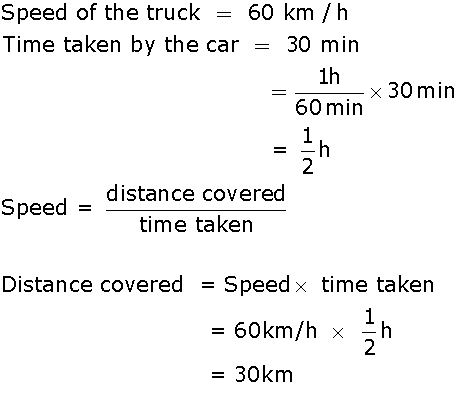A:
The digestive tract and the associated glands.
A:
Temperature of our body can be measured by the help of clinical thermometer.
A:
The rearing of silkworms for obtaining silk is known as sericulture.
A:
Weather is defined as the condition of the atmosphere with respect to the temperature, humidity, rainfall, wind speed etc.
A:
Soil contain the rotting dead matter called as humus.
A:
Tornado is a dark funnel shaped cloud that reaches the ground from the sky. Mostly the tornadoes are weak. They can be form within the cyclones.
A:
The process of breakdown of food in the cell with the release of energy is called cellular respiration.
A:

Carbon dioxide Water chlorophyll Glucose Oxygen
A:
The process of taking out threads from the cocoon for use is known as reeling. e.g. reeling the silk means unwind threads or fibres of silk from the cocoon.
A:
Total distance traveled =2.4km=2.4x1000m=2400m.
Speed is 2m/sec
As time = (Distance/speed)
time=2400/2=1200sec.
A:
Similarity: Both amoeba and human use digestive juices to digest food.
Difference: Human needs to chew food whereas in amoeba, there is no chewing.
A:
Air gets trapped between two thin sweaters. Being a bad conductor of heat, air does not allow the body heat to flow outside. Hence, two thin sweaters keeps us warmer than wearing just one thick sweater.
A:
Polar bears have white fur so that they are not easily visible in the snowy white background, which help it to protect them from their predators. It also helps them in catching their prey. Polar bear have thick layer of fat to protect them from extreme cold.
A:
In summers, near the equator the land warms up faster and most of the time the temperature of the land is higher than that of water in the oceans. Thus, the air above the land gets heated up and rises upwards and the colder air from the oceans rush in, to take its place. These winds which flow from oceans to land are called monsoon winds. These winds from the oceans carry water with them and cause rain.
A:
Wind, rainfall, temperature, light and humidity are the factors which affect the soil.
A:
Earthworms breathe through their moist and slimy skins. Gases can easily pass through them. While frogs have a pair of lungs which are the important organ in the gaseous exchange like human beings. They can also breathe through their skin which is moist and slippery.
A:
Time taken = 20 minutes =20 X 60 seconds = 1200 seconds
Speed = 2 m/s
Distance = speed X time
= (2 X 1200) m
= 2400 m
Since, 1 km = 1000 m
Hence, distance = 2.4 km
A:
(i)The process of removing the fleece of sheep from its body along with a thin layer of skin is called shearing.
(ii)Usually shearing is done during the hot weather.
(iii)The fleece provides woollen fibres that are processed to obtain woollen yarn.
A:
An adaptation is trait of an organism that has been favoured by natural selection. Adaptations are of following types:-
- Structural adaptations are special body parts of an organism that help it to survive in its natural habitat (e.g., skin colour, shape, body covering).
- Behavioral adaptations are special ways of a particular organism that behaves to survive in its natural habitat.
- Physiological adaptations are systems present in an organism that allow it to perform certain biochemical reactions (e.g., making venom, being able to keep a constant body temperature).
A:
The materials which allow heat to pass through them easily are known as conductors. For example-copper, iron etc.
The materials which do not allow heat to pass through them are known as insulators. For example- wood, plastic etc.
A:
When an ant bites, it injects an acidic liquid into the skin, which causes the burning sensation and pain. Calamine solution (Zinc carbonate) is basic in nature. It neutralizes the acid and relieves us from the pain.
A:
Grass eating animals like cows, buffaloes etc. quickly swallow the grass and store it in a separate part of the stomach called rumen.
In rumen, the food is partially digested and is called cud.
The cud returns to the mouth in small lumps and is chewed by the animal. The process is known as rumination and the animals are called ruminants.
A:
When we blow air into the mouth of the bottle, the air has higher speed near the mouth. Due to this, the air pressure decreases there. The air pressure inside the bottle is higher than that near the mouth. The ball is pushed out by the air inside the bottle. This is why a paper doesn’t go inside.
A:
(a) When a pile of cocoons is either boiled or exposed to steam, the silk fibres separate out.
(b) The natural lustrous appearance of silk makes it attractive.
(c) Mulberry silk moth
A:
The differences between a parasite and a saprotroph are as follows:
| Parasite | Saprotroph |
| (1) A parasite mostly lives in or on the living host. (2) Parasite derives nutrients from the living organisms.
Example- Cuscuta (Amarbel) | (1) A saprotroph lives on dead and decaying matter. (2) Saprotroph derives nutrients from dead and decaying organisms.
Example - Fungi |
A:
(a) The climatic conditions in rainforests are highly suitable for supporting an enormous number and variety of animals. Tropical rainforests lie near to the Equator. This region receives rainfall distributed regularly throughout the year, about 6-33 feet a year. It remains frost free and warm all year long, with temperatures between 70° and 85°F with very little daily fluctuation. Because of continuous warmth and rain, this region supports wide variety of plants and animals. The major types of animals living in the rainforests are monkeys, apes, gorillas, lions, tigers, elephants, leopards, lizards, snakes, birds and insects. Tropical rainforests are found in Western Ghats and Assam in India, Southeast Asia, Central America and Central Africa.
(b) To overcome the competition for food and shelter, some animals are adapted to get food which is not easily reachable. Example, red-eyed frog has developed sticky pads on its feet to help to climb tress on which it lives. Another example is of the Toucan bird, which possesses a long, large beak. This helps a toucan to reach the fruits on branches which are otherwise too weak to support its weight.
A:
When an object covers equal distances in equal intervals of time then, it is said to be in uniform motion.
For example: If a car covers 100 km every hour, 50 km every half an hour, 25 km every quarter of an hour and so on, then its motion is said to be uniform.

Therefore, the truck covered a total distance of 30km.
A:
Different layers are referred to as horizons.
- The uppermost layer; the top soil, also called as A-horizon is generally dark in colour and fertile as it is rich in humus and minerals. This layer is generally soft, porous and can retain more water. This provides shelter for many living organisms such as worms, rodents, moles and beetles. The roots of small plants are embedded entirely in the topsoil.
- The next layer;middle layer called B-horizon has a lesser amount of humus but more of minerals. This layer is generally harder and more compact.
- The third layer is the C-horizon , which is made up of small lumps of rocks with cracks and crevices. Below this layer is the bedrock, which is hard and difficult to dig with a spade. water can be held in the tiny gaps.
A:
(a) Neutralisation reaction
(b) (i)No change (ii)No change
(c) Phenolphthalein gives pink colour with basic solution and remains colourless in acidic solution. Therefore, solution (X) is a base.
(d) China rose indicator gives dark pink colour with an acidic solution and green colour with a basic solution.
A:
The process of breathing in humans occurs as follows:
When air is inhaled, it passes through our nostrils into the nasal cavity. With the help of windpipe, the air reaches our lungs from the nasal cavity. From nasal cavity, the air enters the lungs. During inhalation, the ribs move up and outwards and diaphragm moves down. This occurs due to changes in the volume of lungs due to the movements of the rib cage and diaphragm. This movement causes a fall in the lung pressure due to which air rushes into the lungs. During exhalation, ribs move down and inwards, while diaphragm moves up to its former position. This reduces the size of the chest cavity, thereby increasing the pressure in the lungs and air is pushed out of the lungs.
A:
The digestive tract and the associated glands.
A:
Temperature of our body can be measured by the help of clinical thermometer.
A:
The rearing of silkworms for obtaining silk is known as sericulture.
A:
Weather is defined as the condition of the atmosphere with respect to the temperature, humidity, rainfall, wind speed etc.
A:
Soil contain the rotting dead matter called as humus.
A:
Tornado is a dark funnel shaped cloud that reaches the ground from the sky. Mostly the tornadoes are weak. They can be form within the cyclones.
A:
The process of breakdown of food in the cell with the release of energy is called cellular respiration.
A:

Carbon dioxide Water chlorophyll Glucose Oxygen
A:
The process of taking out threads from the cocoon for use is known as reeling. e.g. reeling the silk means unwind threads or fibres of silk from the cocoon.
A:
Total distance traveled =2.4km=2.4x1000m=2400m.
Speed is 2m/sec
As time = (Distance/speed)
time=2400/2=1200sec.
A:
Similarity: Both amoeba and human use digestive juices to digest food.
Difference: Human needs to chew food whereas in amoeba, there is no chewing.
A:
Air gets trapped between two thin sweaters. Being a bad conductor of heat, air does not allow the body heat to flow outside. Hence, two thin sweaters keeps us warmer than wearing just one thick sweater.
A:
Polar bears have white fur so that they are not easily visible in the snowy white background, which help it to protect them from their predators. It also helps them in catching their prey. Polar bear have thick layer of fat to protect them from extreme cold.
A:
In summers, near the equator the land warms up faster and most of the time the temperature of the land is higher than that of water in the oceans. Thus, the air above the land gets heated up and rises upwards and the colder air from the oceans rush in, to take its place. These winds which flow from oceans to land are called monsoon winds. These winds from the oceans carry water with them and cause rain.
A:
Wind, rainfall, temperature, light and humidity are the factors which affect the soil.
A:
Earthworms breathe through their moist and slimy skins. Gases can easily pass through them. While frogs have a pair of lungs which are the important organ in the gaseous exchange like human beings. They can also breathe through their skin which is moist and slippery.
A:
Time taken = 20 minutes =20 X 60 seconds = 1200 seconds
Speed = 2 m/s
Distance = speed X time
= (2 X 1200) m
= 2400 m
Since, 1 km = 1000 m
Hence, distance = 2.4 km
A:
(i)The process of removing the fleece of sheep from its body along with a thin layer of skin is called shearing.
(ii)Usually shearing is done during the hot weather.
(iii)The fleece provides woollen fibres that are processed to obtain woollen yarn.
A:
An adaptation is trait of an organism that has been favoured by natural selection. Adaptations are of following types:-
- Structural adaptations are special body parts of an organism that help it to survive in its natural habitat (e.g., skin colour, shape, body covering).
- Behavioral adaptations are special ways of a particular organism that behaves to survive in its natural habitat.
- Physiological adaptations are systems present in an organism that allow it to perform certain biochemical reactions (e.g., making venom, being able to keep a constant body temperature).
A:
The materials which allow heat to pass through them easily are known as conductors. For example-copper, iron etc.
The materials which do not allow heat to pass through them are known as insulators. For example- wood, plastic etc.
A:
When an ant bites, it injects an acidic liquid into the skin, which causes the burning sensation and pain. Calamine solution (Zinc carbonate) is basic in nature. It neutralizes the acid and relieves us from the pain.
A:
Grass eating animals like cows, buffaloes etc. quickly swallow the grass and store it in a separate part of the stomach called rumen.
In rumen, the food is partially digested and is called cud.
The cud returns to the mouth in small lumps and is chewed by the animal. The process is known as rumination and the animals are called ruminants.
A:
When we blow air into the mouth of the bottle, the air has higher speed near the mouth. Due to this, the air pressure decreases there. The air pressure inside the bottle is higher than that near the mouth. The ball is pushed out by the air inside the bottle. This is why a paper doesn’t go inside.
A:
(a) When a pile of cocoons is either boiled or exposed to steam, the silk fibres separate out.
(b) The natural lustrous appearance of silk makes it attractive.
(c) Mulberry silk moth
A:
The differences between a parasite and a saprotroph are as follows:
| Parasite | Saprotroph |
| (1) A parasite mostly lives in or on the living host. (2) Parasite derives nutrients from the living organisms.
Example- Cuscuta (Amarbel) | (1) A saprotroph lives on dead and decaying matter. (2) Saprotroph derives nutrients from dead and decaying organisms.
Example - Fungi |
A:
(a) The climatic conditions in rainforests are highly suitable for supporting an enormous number and variety of animals. Tropical rainforests lie near to the Equator. This region receives rainfall distributed regularly throughout the year, about 6-33 feet a year. It remains frost free and warm all year long, with temperatures between 70° and 85°F with very little daily fluctuation. Because of continuous warmth and rain, this region supports wide variety of plants and animals. The major types of animals living in the rainforests are monkeys, apes, gorillas, lions, tigers, elephants, leopards, lizards, snakes, birds and insects. Tropical rainforests are found in Western Ghats and Assam in India, Southeast Asia, Central America and Central Africa.
(b) To overcome the competition for food and shelter, some animals are adapted to get food which is not easily reachable. Example, red-eyed frog has developed sticky pads on its feet to help to climb tress on which it lives. Another example is of the Toucan bird, which possesses a long, large beak. This helps a toucan to reach the fruits on branches which are otherwise too weak to support its weight.
A:
When an object covers equal distances in equal intervals of time then, it is said to be in uniform motion.
For example: If a car covers 100 km every hour, 50 km every half an hour, 25 km every quarter of an hour and so on, then its motion is said to be uniform.

Therefore, the truck covered a total distance of 30km.
A:
Different layers are referred to as horizons.
- The uppermost layer; the top soil, also called as A-horizon is generally dark in colour and fertile as it is rich in humus and minerals. This layer is generally soft, porous and can retain more water. This provides shelter for many living organisms such as worms, rodents, moles and beetles. The roots of small plants are embedded entirely in the topsoil.
- The next layer;middle layer called B-horizon has a lesser amount of humus but more of minerals. This layer is generally harder and more compact.
- The third layer is the C-horizon , which is made up of small lumps of rocks with cracks and crevices. Below this layer is the bedrock, which is hard and difficult to dig with a spade. water can be held in the tiny gaps.
A:
(a) Neutralisation reaction
(b) (i)No change (ii)No change
(c) Phenolphthalein gives pink colour with basic solution and remains colourless in acidic solution. Therefore, solution (X) is a base.
(d) China rose indicator gives dark pink colour with an acidic solution and green colour with a basic solution.
A:
The process of breathing in humans occurs as follows:
When air is inhaled, it passes through our nostrils into the nasal cavity. With the help of windpipe, the air reaches our lungs from the nasal cavity. From nasal cavity, the air enters the lungs. During inhalation, the ribs move up and outwards and diaphragm moves down. This occurs due to changes in the volume of lungs due to the movements of the rib cage and diaphragm. This movement causes a fall in the lung pressure due to which air rushes into the lungs. During exhalation, ribs move down and inwards, while diaphragm moves up to its former position. This reduces the size of the chest cavity, thereby increasing the pressure in the lungs and air is pushed out of the lungs.






